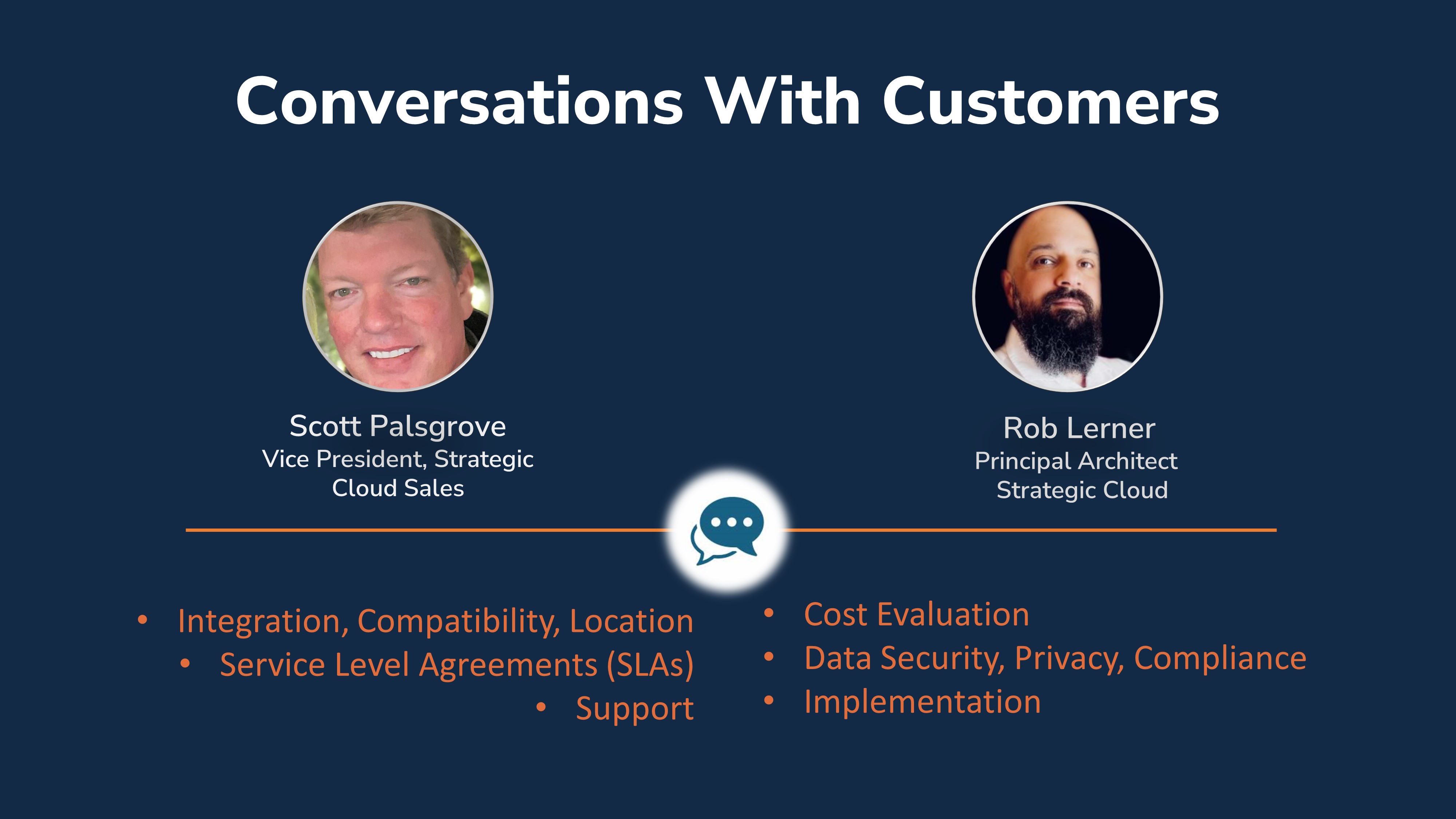Migrating to the cloud has become less of a trend and more of a necessity for businesses seeking scalability, flexibility, and efficiency. However, the journey to the cloud is not without its complexities. To ensure a smooth transition and maximize the benefits of cloud adoption, it’s crucial for organizations to carefully evaluate various considerations. Let’s delve into some key factors to keep in mind when making the leap to the cloud. Watch the video HERE.
Assessment of Current Infrastructure: Before embarking on the cloud migration journey, it is essential to conduct a comprehensive assessment of your current infrastructure. This involves evaluating existing hardware, software, and applications to determine compatibility with cloud environments. Understanding your organization’s unique IT landscape will help in devising a tailored migration strategy and minimizing potential disruptions during the transition.
Security and Compliance: Security concerns often top the list of reasons why businesses hesitate to migrate to the cloud. While cloud providers offer robust security measures, organizations must ensure compliance with industry regulations and data protection standards. The critical steps in safeguarding sensitive data throughout the migration process and beyond are assessing the security posture of cloud providers, implementing encryption protocols, and establishing access controls.
Cost Management: While the cloud offers cost-saving benefits through pay-as-you-go models and resource optimization, it is essential to have a clear understanding of pricing structures and potential hidden costs. Establishing a cost management strategy involves accurately estimating usage requirements, optimizing resource allocation, and regularly monitoring cloud spending. Implementing cloud cost management tools and leveraging discounts and reserved instances can help in controlling expenses and maximizing ROI (return on investment).
Data Migration and Integration: Migrating vast amounts of data to the cloud requires careful planning and execution to avoid data loss or corruption. Organizations must assess data dependencies, prioritize migration tasks, and choose the appropriate migration methods, whether it is through bulk transfers, streaming, or hybrid approaches. Additionally, integrating cloud services with existing systems and applications requires seamless connectivity and compatibility to ensure uninterrupted operations.
Scalability and Performance: One key advantage of cloud computing is its ability to scale resources dynamically based on demand. However, achieving optimal scalability and performance requires strategic planning and resource optimization. Organizations should design architectures that can efficiently handle fluctuating workloads, leverage auto-scaling capabilities, and implement performance monitoring tools to ensure consistent performance and user experience.
Training and Skill Development: Transitioning to the cloud often necessitates upskilling or reskilling IT teams to effectively manage cloud environments and technologies. Assessing internal expertise and identifying skill gaps can help in developing targeted training programs and initiatives to bridge the knowledge gap. Providing comprehensive training programs and certifications can empower employees with the knowledge and skills required to leverage cloud platforms efficiently. Additionally, fostering a culture of continuous learning and experimentation encourages innovation and enhances the organization’s ability to adapt to evolving cloud technologies.
Vendor Selection and Support: Choosing the right cloud provider is a critical decision that can significantly impact the success of your migration journey. Evaluating factors such as reliability, performance, service-level agreements (SLAs), and customer support is essential in selecting a vendor that aligns with your business needs and goals. Additionally, establishing clear communication channels and building strong partnerships with cloud providers can ensure timely support and assistance throughout the migration process and beyond.

Assessment of Internal Expertise, Skills, and Priorities: Evaluating your organization’s internal expertise, skills, and priorities is crucial for a successful cloud migration. Assessing your IT team’s capabilities and understanding their proficiency with cloud technologies can help determine the level of support and training required. Additionally, aligning cloud migration priorities with business objectives and IT initiatives ensures that resources are allocated effectively, and migration efforts are focused on achieving tangible outcomes.
Planning, Roadmap, and Implementation Timelines: Developing a comprehensive migration plan and roadmap is essential for guiding the cloud migration process from start to finish. This involves defining clear objectives, identifying migration strategies, and establishing realistic timelines and milestones. Collaborating with key stakeholders and cloud partners helps in prioritizing workloads, allocating resources, and ensuring alignment with business goals. Implementing phased migration approaches and conducting regular progress reviews facilitate smooth execution and minimize disruptions to ongoing operations.
Impact on Operations: Assessing the potential impact of cloud migration on existing operations is critical for managing change and mitigating risks. Organizations should evaluate factors such as application dependencies, user workflows, and performance expectations to anticipate and address operational challenges effectively. Implementing contingency plans, conducting thorough testing, and providing adequate user training and support help to minimize downtime and ensure business continuity during the migration process.
RACI with Your Partner: Establishing clear roles and responsibilities (RACI) with your cloud migration partner is essential for ensuring accountability and collaboration throughout the migration journey. Defining who is Responsible, Accountable, Consulted, and Informed for each task and decision streamlines communication, fosters teamwork, and minimizes misunderstandings. Collaborating closely with your partner enables efficient knowledge transfer, risk management, and resolution of issues, ultimately leading to a successful cloud migration outcome.
Application Modernization: As organizations migrate their applications to the cloud, they should seize the opportunity to modernize their application architecture and design. Legacy applications may require refactoring or redesigning to take full advantage of cloud-native features such as microservices, containerization, and serverless computing. Application modernization not only improves performance and scalability but also enhances agility and enables faster time-to-market for new features and updates.
Disaster Recovery and Business Continuity: Implementing robust disaster recovery (DR) and business continuity (BC) plans is essential to mitigate the risk of downtime and data loss in the cloud environment. Organizations should replicate critical data and workloads across multiple geographic regions to ensure high availability and resilience against infrastructure failures or natural disasters. Regular testing of DR/BC procedures and automation of failover processes are key to maintaining operational continuity and minimizing downtime during unforeseen events.
Governance and Compliance Management: Effective governance frameworks are essential for maintaining control, visibility, and compliance in the cloud. Establishing clear policies, procedures, and controls helps in managing cloud resources, enforcing security standards, and ensuring regulatory compliance. Implementing cloud governance tools and conducting regular audits can help organizations monitor and enforce adherence to compliance requirements, data privacy regulations, and internal policies across cloud environments.
Performance Optimization: Continuous performance optimization is crucial for maximizing the efficiency and cost-effectiveness of cloud resources. Monitoring key performance metrics, identifying performance bottlenecks, and fine-tuning configurations are essential for achieving optimal performance and resource utilization. Employing performance optimization techniques such as caching, load balancing, and content delivery networks (CDNs) can enhance application responsiveness and user experience while minimizing latency and infrastructure costs.
Data Governance and Management: As data volumes grow exponentially in the cloud, organizations must prioritize data governance and management to ensure data quality, integrity, and security. Implementing data governance frameworks, metadata management solutions, and data lifecycle management policies helps in effectively managing data assets, enforcing data governance policies, and facilitating regulatory compliance. Leveraging
By incorporating these considerations into your cloud migration strategy, organizations can enhance the success and sustainability of their cloud initiatives while addressing key challenges and maximizing the benefits of cloud adoption. From application modernization and disaster recovery to governance and performance optimization, each aspect plays a vital role in shaping a comprehensive and resilient cloud strategy that aligns with the organization’s objectives and drives long-term business value. Embracing the cloud as a strategic enabler can empower businesses to thrive in today’s dynamic digital landscape.

After you’ve read our blog, be sure to watch our video featuring Rob Lerner, DataBank’s Principal Cloud Architect, and Scott Palsgrove, DataBank’s VP of Strategic Cloud Sales, as they discuss conversations with customers about moving to the Cloud.
Additional Resources
What Should You Expect When Considering Managed IT Services?
Why Disaster Recovery as a Service?
Download the Next-Generation Solutions for Disaster Recovery White Paper






